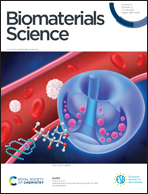A highly stable multifunctional aptamer for enhancing antitumor immunity against hepatocellular carcinoma by blocking dual immune checkpoints†
Abstract
T-lymphocytes play a potent role in cancer immunotherapy; while, limited tumor infiltrating lymphocytes (TILs) combined with severe immunosuppression always significantly hinder their antitumor immune responses, especially in solid tumors such as hepatocellular carcinoma (HCC). Here, we prepared a highly stable multifunctional aptamer for strengthening antitumor immunity against HCC solid tumors through a dual immune checkpoint blockade of CTLA-4 and PD-L1. The engineered multifunctional aptamer (termed P1/C4-bi-apt) can block both CTLA-4/B7 and PD-1/PD-L1 signaling pathways and thus enhance the antitumor immune responses. Furthermore, it can direct CTLA-4-positive T cells to infiltrate into tumors to further enhance the antitumor efficacy compared to a single blockage of CTLA-4 or PD-L1. As a result, the multifunctional aptamer can significantly inhibit tumor growth and thus improve the long-term survival of HCC-bearing mice. The designed multifunctional aptamer is simple, stable and easy to prepare, and it can significantly strengthen the functionality of T cells, holding great potential for HCC immunotherapy.



 Please wait while we load your content...
Please wait while we load your content...